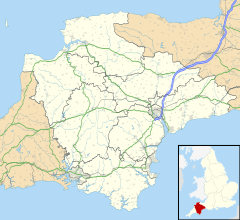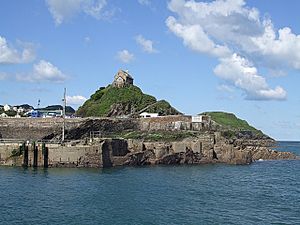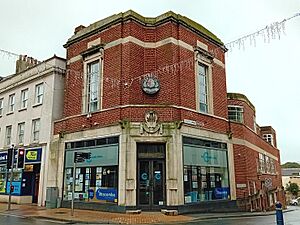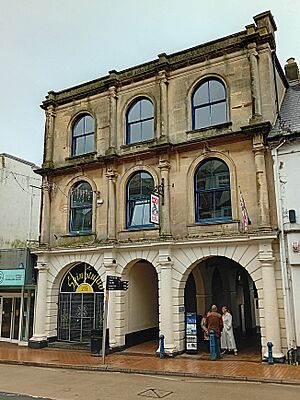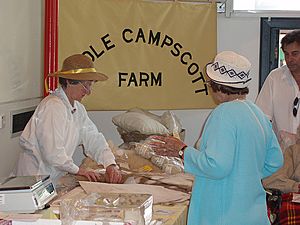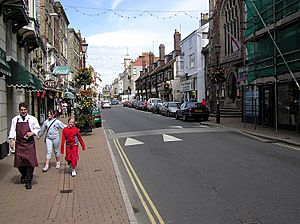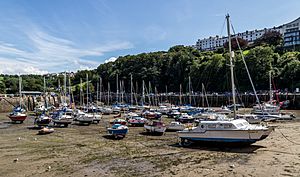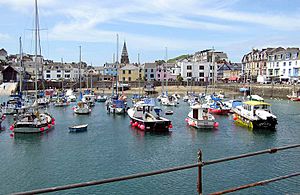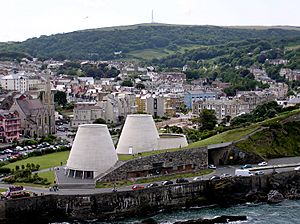Ilfracombe facts for kids
Quick facts for kids Ilfracombe |
|
|---|---|
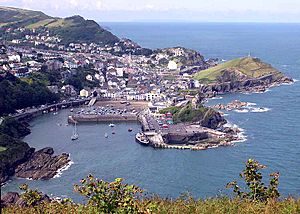 Ilfracombe seen from Hillsborough |
|
| Population | 11,042 (2021 parish census) |
| OS grid reference | SS516474 |
| Civil parish |
|
| District |
|
| Shire county | |
| Region | |
| Country | England |
| Sovereign state | United Kingdom |
| Post town | ILFRACOMBE |
| Postcode district | EX34 |
| Dialling code | 01271 |
| Police | Devon and Cornwall |
| Fire | Devon and Somerset |
| Ambulance | South Western |
| EU Parliament | South West England |
| UK Parliament |
|
| Website | www.ilfracombetowncouncil.gov.uk |
Ilfracombe is a lovely seaside resort town on the North Devon coast in England. It has a small harbour surrounded by tall cliffs.
The town stretches along the coast from Hele Bay in the east to Lee Bay in the west. It's a hilly place, and its highest point, 'Hore Down Gate', is about 270 meters (860 feet) above sea level.
A big hill called Hillsborough overlooks the harbour. It was once an Iron Age fort. The Landmark Theatre is a famous building with a unique double-cone shape. Other interesting spots include the 13th-century Holy Trinity and the old St Nicholas's Chapel, which acts as a lighthouse. More recently, a large statue called Verity by artist Damien Hirst has become a popular landmark.
Contents
Discovering Ilfracombe's Past
Ilfracombe has been lived in since the Iron Age. Back then, a group of people called the Dumnonii built a fort on Hillsborough hill. The town's name might come from an old Anglo-Saxon word, Alfreinscoma, meaning "Valley of the sons of Alfred". Another idea is that it comes from Norse and Anglo-Saxon words meaning "The valley with the bad ford".
The old manor house at Chambercombe was built by a Norman knight around 1086. People say it's haunted!
Ilfracombe used to have two main parts: a farming area around the parish church (Holy Trinity) and a fishing village by the natural harbour. The church lands belonged to the Champernowne family, while the harbour lands were owned by the Bouchier family.
Because of its natural shape, Ilfracombe's harbour became a very safe and important port on the Bristol Channel. It had trade routes to places like Kinsale and Tenby. In 1208, Ilfracombe provided ships and men to King John for an invasion of Ireland. Later, it sent ships to help conquer the Western Isles of Scotland and support the siege of Calais. The building on Lantern Hill, called St Nicholas's Chapel (built in 1361), is thought to be the oldest working lighthouse in the UK. It has had a light for over 650 years!
The Bowen family, who were important naval officers, lived here. James Bowen was a sailing master in a famous naval battle in 1794. He later became a Rear Admiral. His younger brother, Captain Richard Bowen, served under Lord Nelson and died in battle. James Bowen's son, John, founded the first settlement in Tasmania, which is now Hobart.
There was once a wooden fort overlooking the harbour, but nothing is left of it today.
The writer Fanny Burney visited Ilfracombe in 1817. Her diary shows what life was like then, mentioning captured ships and storms. In the 1820s, Welsh miners carved four tunnels through the cliffs. These tunnels allowed people to reach the beaches by horse-drawn carriage or on foot. Before, you had to climb the cliffs or go by boat. The tunnels led to tidal pools, where men and women used to swim separately. You can still visit these tunnels today, known as Tunnels Beaches.
In 1856, the writer Mary Ann Evans came to Ilfracombe to gather ideas for a book.
Ilfracombe got its first lifeboat in 1828. A permanent Royal National Lifeboat Institution station was built near the pier in 1866. The current station opened in 1996.
In 1912, a young woman from Ilfracombe, Alice Phillips, survived the sinking of the Titanic. Her father, however, was lost in the disaster.
How Ilfracombe is Governed
Ilfracombe has three levels of local government. These are the Ilfracombe Town Council, the North Devon Council (based in Barnstaple), and the Devon County Council (based in Exeter). The Town Council works from the Ilfracombe Centre on High Street.
Ilfracombe has been an important area for a long time. In 1851, a local board was created to manage the town. This board built a town hall in 1863. Later, in 1894, the local board became the Ilfracombe Urban District Council.
In 1974, the Ilfracombe Urban District Council was replaced by the new North Devon district. A new Ilfracombe Town Council was then formed. In 1997, the Town Council moved to its current home at 44 High Street, now called the Ilfracombe Centre.
The town is part of the North Devon area for national elections. It has been represented by different political parties over the years.
Ilfracombe is also "twinned" with Ifs in France. This means the towns have a special friendship and cultural exchange.
Ilfracombe's Landscape
Ilfracombe is built on slate rocks that were formed about 300 million years ago. These rocks were pushed and folded by huge geological forces.
The town is located within the North Devon Areas of Outstanding Natural Beauty. This area is famous for its amazing coastal cliffs and scenery. Hillsborough, near the town centre, is a special nature reserve. Many other places around Ilfracombe are home to diverse and rare wildlife. The coast itself is part of the North Devon Voluntary Marine Conservation area.
Ilfracombe's Economy
For a long time, Ilfracombe's economy relied on sea activities. This included importing lime and coal from Wales, fishing for herring, and trading with other countries, even as far as West Africa and the West Indies.
In the mid-1800s, Ilfracombe started to become a popular tourist spot. Ferries brought visitors along the Bristol Channel. When the railway opened, tourism grew even faster. The town's population increased until the First World War.
However, in the 1960s, holiday habits changed, and the economy suffered. The railway line closed in 1970, which made things harder.
In recent years, new businesses have helped the economy. Companies like Pall Europe (which makes filters) and TDK-Lambda (which makes power supplies) have set up here. There are also smaller engineering firms. Three deep-sea fishing boats and several inshore boats still operate from the harbour, catching lobsters, crabs, and whelks. Many private boats offer sea cruises and coastal tours.
Getting Around Ilfracombe
Roads
Ilfracombe is at the end of the A361, a long road that connects the town to the M5 in South West England. This is the main road in and out of Ilfracombe.
Buses and Trains
From 1874 to 1970, Ilfracombe had its own railway line to Barnstaple. Now, the closest train station is in Barnstaple. Buses connect Ilfracombe to Barnstaple and other nearby towns. There are also local bus services within Ilfracombe.
Ferries
Steam ferries started arriving in Ilfracombe in 1823, offering regular trips to Bristol and Swansea. In 1873, a wooden pier was built so these pleasure steamers could dock easily. By 1894, thousands of people were arriving by boat, bringing holidaymakers and goods.
The PS Waverley (1885), a famous paddle steamer, started coming to Ilfracombe in 1887. After the old wooden pier was damaged in the Second World War, a new concrete pier was built in 1952.
Today, a seasonal passenger ferry, the MS Oldenburg, connects Ilfracombe harbour to Lundy Island. Other pleasure boats, like the MV Balmoral and PS Waverley, offer seasonal cruises from Ilfracombe.
Learning in Ilfracombe
Ilfracombe has three main schools: an infants school, a junior school, and the Ilfracombe Academy. These are some of the largest schools of their kind in Devon. The Ilfracombe Academy serves students from Ilfracombe and the wider coastal area, including places like Lynton and Lynmouth. It's known for its arts programs.
The Ilfracombe Museum opened in 1932. It's full of interesting items from around the world, including some quirky things like pickled bats! It also has local history items, like parts of the old railway station and pieces of Victorian wedding cake.
Ilfracombe also has a public library.
Famous Places in Ilfracombe
Ilfracombe has many different types of buildings, from old 13th-century streets to modern designs. You can see beautiful Georgian and Regency houses, especially from the 1800s when the town grew a lot. The Landmark Theatre is a great example of modern architecture.
Verity is a huge 20-meter (66-foot) tall statue by Damien Hirst. It stands on the pier at the harbour entrance. The statue shows a pregnant woman holding a sword and the scales of justice. One side of the statue shows her internal body, including the foetus. It's meant to represent "truth and justice."
Places of Worship
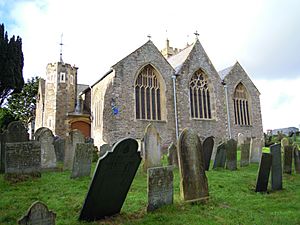
Ilfracombe has many churches for different Christian groups. The main Anglican church is Holy Trinity. Other churches include St Philip and St James, Brookdale Evangelical Church, Encounter Church, and Ilfracombe Baptist Church. There's also the Roman Catholic Our Lady Star of the Sea Church, the Methodist/United Reformed Emmanuel Church, and the Salvation Army.
The Lighthouse
| Location | Lantern Hill, Ilfracombe |
|---|---|
| Coordinates | 51°12′40″N 4°06′47″W / 51.211135°N 4.113009°W |
| Year first constructed | 1321 (first) |
| Year first lit | 1819 (current) |
| Construction | stone chapel |
| Markings / pattern | white lantern on the top |
| Height | 11 metres (36 ft) |
| Focal height | 39 metres (128 ft) |
| Characteristic | Fl G 2.5s. |
For hundreds of years, a light has shone from the 14th-century chapel on Lantern Hill to guide ships into the harbour. This light is still working today and is said to be Britain's oldest lighthouse! The current light was put in by Trinity House in 1819. The chapel is now owned by the North Devon Council and is open to visitors in the summer.
Sports and Fun Activities
Ilfracombe has many sports clubs. The Ilfracombe Rugby Union Club started in 1877. The Ilfracombe Golf Club opened in 1892. The Ilfracombe cricket club plays at Brimlands, sharing a site with the rugby club.
The Ilfracombe Running Club was formed in 2013. Ilfracombe Town Football Club plays at Marlborough Park. There's also a tennis club at Bicclescombe Park.
For water activities, there's a popular yacht club and a Gig boat club. The Gig boats now compete in world championships!
The South West Coast Path, a long walking trail, passes through Ilfracombe, offering amazing coastal views.
In 2009, Gethin Jones became the first person to swim from Ilfracombe to Swansea, a distance of over 56 kilometers (35 miles). In 2016, Sian Clement became the first woman to complete the swim, setting a new fastest time.
Town Development
Since 2001, there have been efforts to improve Ilfracombe's economy and physical appearance. Plans include making the harbour area even better and building new homes. There are also ideas for developing the old bus station site and creating better facilities for young people near the harbour.
Ilfracombe's Culture

Every year, the people of Ilfracombe celebrate their history and culture.
The town has 10 small art galleries. You can see art at the Art Society gallery, the Landmark Theatre, and "Number Eleven, The Quay," which often shows works by Damien Hirst.
Two fun charity events happen each summer on Ilfracombe Pier. The "South West Birdman" contest involves people trying to "fly" from the pier in homemade flying machines. "Rescue Day" lets the public learn about the emergency services.
Performing Arts
Small Pond Productions is Ilfracombe's main theatre group. Since 2002, they have put on musicals, concerts, and plays throughout the year, often at the Landmark Theatre.
Ilfracombe's Fires
Ilfracombe has experienced several big fires over the years. The "Great Fire of Ilfracombe" happened on July 28, 1896. It started in a shop and destroyed 35 houses and businesses. The local volunteer fire brigade worked hard to put it out.
The same area was hit by fires twice in the 1980s. In 1981, a paint store caught fire. In 1983, a much larger fire started in a shopping arcade, and sadly, one person died. The site of this fire later became the Candar residential apartments.
In 2006, a fire broke out at the old Montebello Hotel. It was a huge blaze that required many fire engines and spread to nearby buildings. The hotel was completely destroyed.
Ilfracombe's Climate
| Climate data for Ilfracombe (1930–1989 averages) | |||||||||||||
|---|---|---|---|---|---|---|---|---|---|---|---|---|---|
| Month | Jan | Feb | Mar | Apr | May | Jun | Jul | Aug | Sep | Oct | Nov | Dec | Year |
| Mean daily maximum °C (°F) | 9 (48) |
9 (48) |
11 (52) |
13 (55) |
16 (61) |
19 (66) |
21 (70) |
20 (68) |
19 (66) |
15 (59) |
12 (54) |
10 (50) |
15 (58) |
| Mean daily minimum °C (°F) | 4 (39) |
4 (39) |
4 (39) |
6 (43) |
8 (46) |
11 (52) |
13 (55) |
13 (55) |
11 (52) |
9 (48) |
6 (43) |
4 (39) |
8 (46) |
| Average precipitation mm (inches) | 121.9 (4.80) |
87.3 (3.44) |
93.5 (3.68) |
68.2 (2.69) |
73.7 (2.90) |
74.4 (2.93) |
81.7 (3.22) |
89.1 (3.51) |
104.4 (4.11) |
151.6 (5.97) |
138.8 (5.46) |
135.6 (5.34) |
1,220.2 (48.05) |
| Mean monthly sunshine hours | 50.0 | 72.0 | 130.4 | 175.2 | 213.2 | 221.9 | 199.9 | 194.1 | 143.2 | 97.6 | 57.6 | 43.7 | 1,598.8 |
See Also
 In Spanish: Ilfracombe para niños
In Spanish: Ilfracombe para niños


